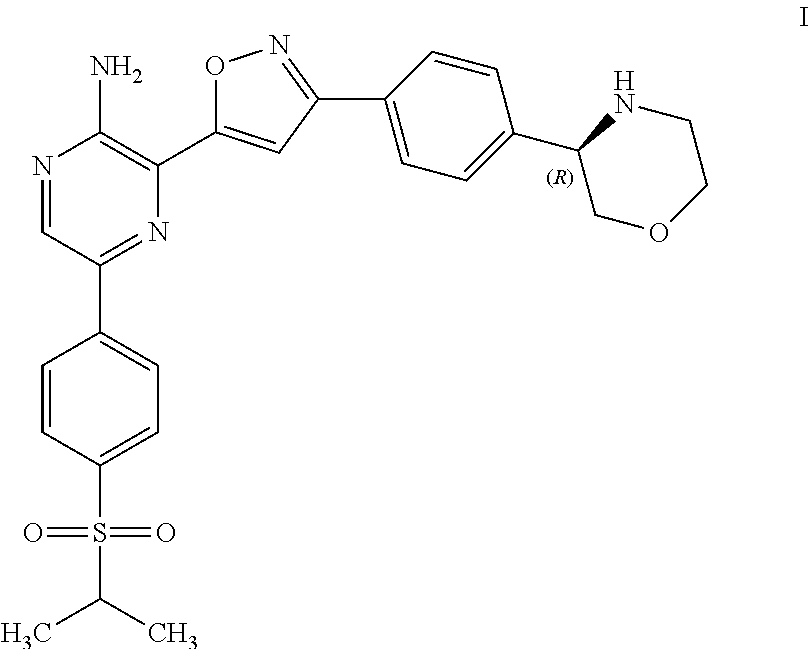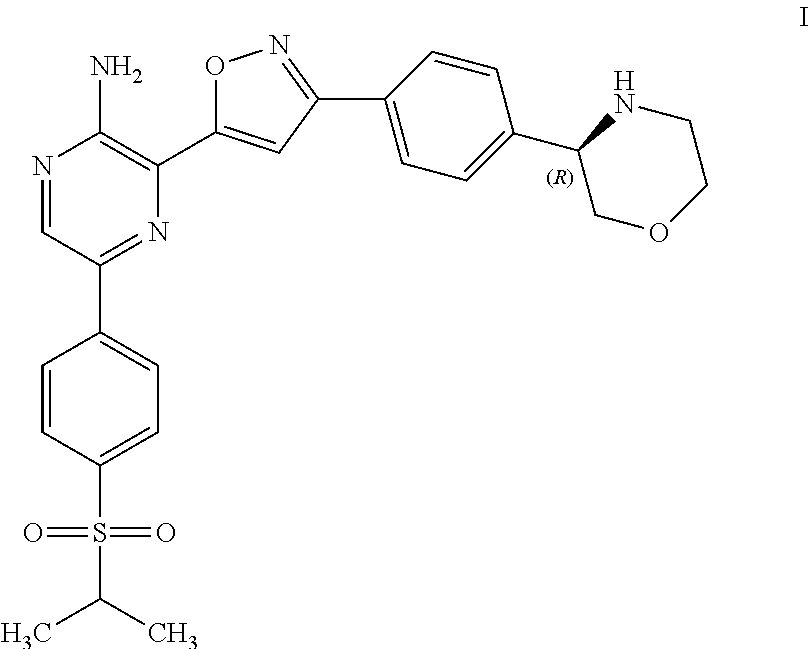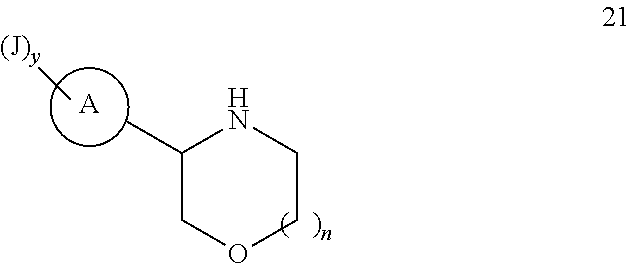Compounds useful as inhibitors of ATR kinase
a technology of atr kinase and compounds, applied in the field of compounds useful as inhibitors of atr kinase, can solve the problems of surprising good pk profile, and achieve the effects of low clearance, good pk profile, and low volume of distribution
- Summary
- Abstract
- Description
- Claims
- Application Information
AI Technical Summary
Benefits of technology
Problems solved by technology
Method used
Image
Examples
example 2
3-(4-(methoxycarbonyl)phenyl)morpholin-4-ium chloride
Step 1: Teat-butyl 3-oxomorpholine-4-carboxylate
[0250]
[0251]Morpholin-3-one (35 g, 346.2 mmol) was slurried in dry THF (350 ml). Tert-butoxycarbonyl tert-butyl carbonate (105.8 g, 111.4 mmol) was added, followed by DMAP (4.2 g, 34.6 mmol). The mixture began to degass rapidly over 30 minutes. The resulting orange solution was stirred at ambient temperature for 24 hrs. The mixture was then cooled in an ice bath and imidazole (23.57 g, 346.2 mmol) was added. After stirring for 30 minutes ethyl acetate (500 ml) was added. The organic phase was separated and washed with 1% (v / v) HCl (500 ml), then sat NaHCO3 (500 ml), then brine (200 ml), dried (MgSO4), filtered and concentrated. The crude was purified through a plug of silica gel, eluting with ethyl acetate. The filtrate was evaporated to give an oil. 40 / 60 pet ether (200 ml) was added slowly with stirring to generate a white solid. The mixture was aged for 30 minutes, cooled briefly ...
example 3a
tert-butyl 5-phenyl-2H-1,4-oxazine-4(3H)-carboxylate
[0262]
[0263]This compound was prepared from tert-butyl 5-((diphenoxyphosphoryl)oxy)-2H-1,4-oxazine-4(3H)-carboxylate and phenylboronic acid using a procedure similar to that described in Example 2 (Steps 1-3a) above. The product was isolated as a white solid (56% yield); 1H-NMR (d6-DMSO) 1.04 (9H, s), 3.68 (2H, m), 4.09 (2H, m), 6.38 (1H, s), 7.18-7.20 (3H, m), 7.27-7.29 (2H, m); 13C-NMR (CDCl3) 27.7, 41.5, 66.8, 125.0, 126.3, 128.0, 132.2; MS ES(+) 206.0 (M+-tBu); HRMS m / z calcd for C15H19NO3+H+ 262.1443 [M+H+]. Found 262.1447. IR λmax=3441, 1701, 1367, 1355, 1163 cm−1.
example 3b
3-phenylmorpholin-4-ium 2,2,2-trifluoroacetate
[0264]
[0265]Tert-butyl 5-phenyl-2H-1,4-oxazine-4(3H)-carboxylate (170 mg, 0.65 mmol) was dissolved in methanol (10 ml). 10% Pd / c (100 mg) was added and the mixture stirred under hydrogen for 18 hours. The catalyst was removed by filtration and the filtrate concentrated to give crude tert-butyl 3-phenylmorpholine-4-carboxylate. The crude product was dissolved in DCM (10 ml) and TFA (1 ml) was added. The mixture was stirred at room temperature for 4 hours. The mixture was then concentrated and the crude purified by reverse phase HPLC (90 / 10 acetonitrile / water). The subtitle compound was obtained as a white solid (130 mg, 73%); 1H-NMR (d6-DMSO) 3.26 (2H, brm), 3.72-3.81 (2H, m), 4.00-4.03 (2H, m), 4.49 (1H, m), 7.45-7.53 (5H, m), 9.27 (2H, brs); 13C-NMR (d6-DMSO) 43.5, 57.7, 62.8, 68.2, 127.7, 128.9, 129.3; MS ES(+) 164.1 (M++1); HRMS m / z calcd for C10H13NO+H+ 164.1075 [M+H+]. Found 164.1082. IR λmax=1659 cm−1.
PUM
| Property | Measurement | Unit |
|---|---|---|
| temperature | aaaaa | aaaaa |
| temperature | aaaaa | aaaaa |
| temperature | aaaaa | aaaaa |
Abstract
Description
Claims
Application Information
 Login to View More
Login to View More - R&D
- Intellectual Property
- Life Sciences
- Materials
- Tech Scout
- Unparalleled Data Quality
- Higher Quality Content
- 60% Fewer Hallucinations
Browse by: Latest US Patents, China's latest patents, Technical Efficacy Thesaurus, Application Domain, Technology Topic, Popular Technical Reports.
© 2025 PatSnap. All rights reserved.Legal|Privacy policy|Modern Slavery Act Transparency Statement|Sitemap|About US| Contact US: help@patsnap.com



